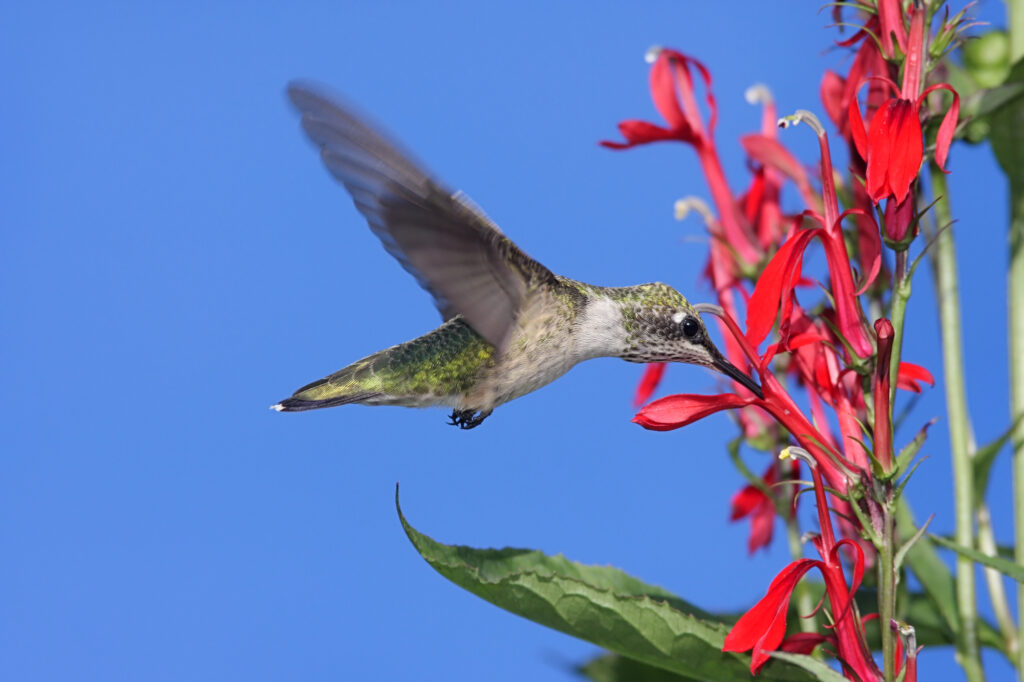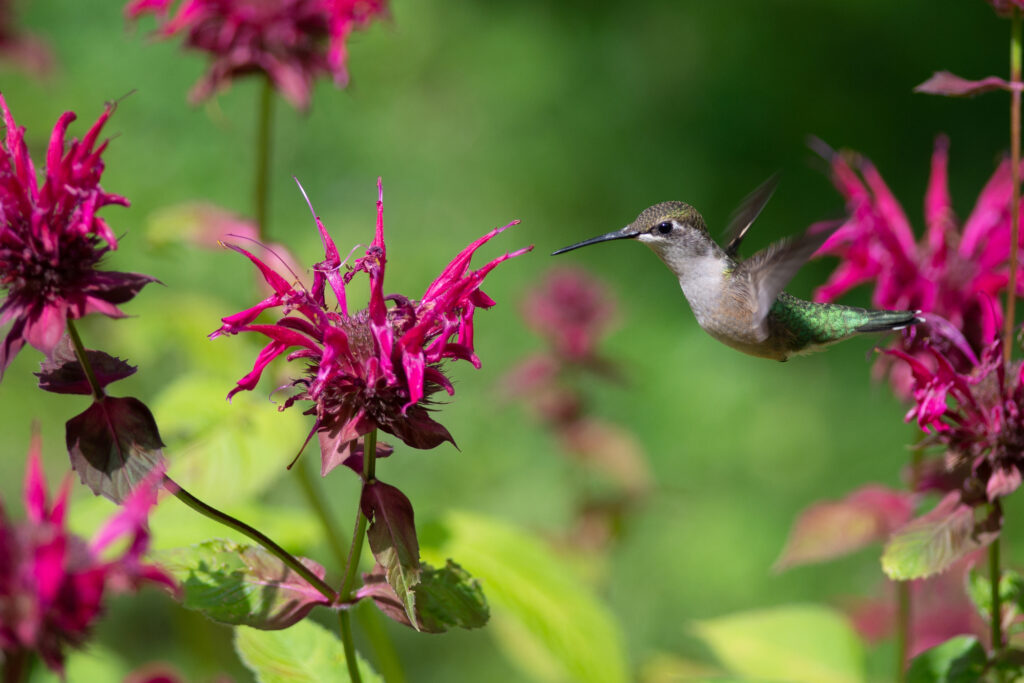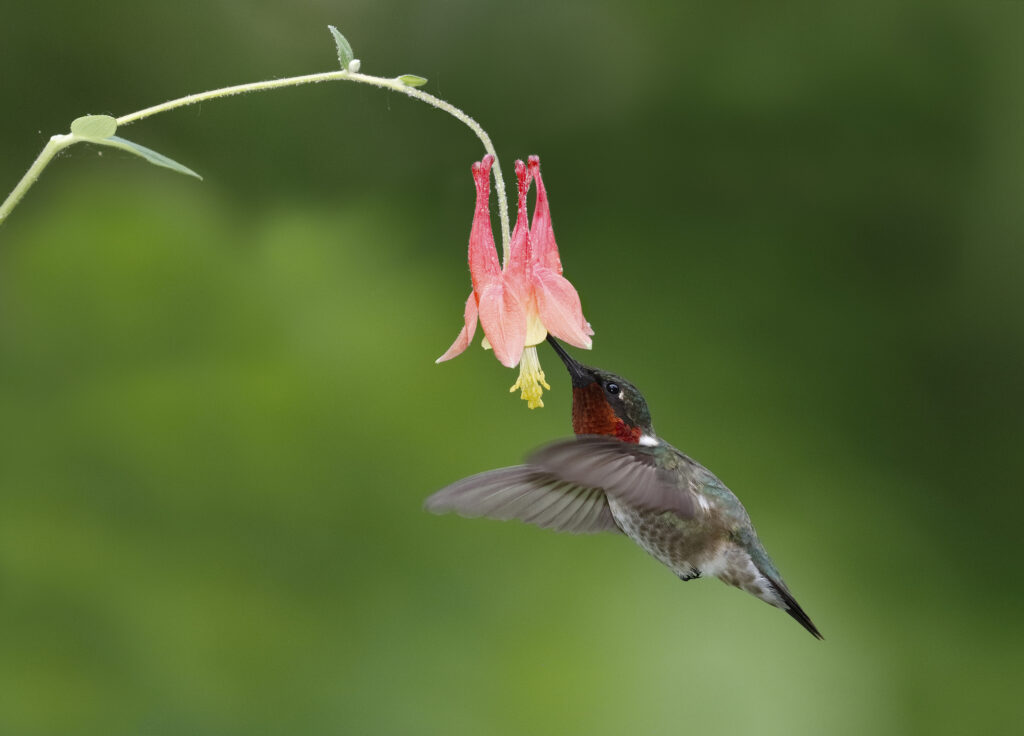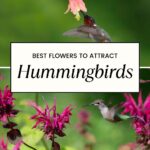Bird watchers are constantly in search of flowers to feed their backyard hummingbirds, from tried and true hummingbird favorites to new ideas they find at a local greenhouse.
In general, hummingbirds like tubular flowers that provide abundant nectar to power their everyday actions.
Hummingbirds must eat constantly, with their extremely high metabolisms requiring them to eat the human equivalent of 155,000 calories, according to the San Diego Zoo. That means a hummingbird will visit between 1,000 and 2,000 flowers per day, via the National Audubon Society.
Most of a hummingbird’s diet is actually insects and spiders, but the sweet nectar of flowers is still a key part of their diet.
Here are some of the flowers you can plant to attract hummingbirds to your yard, but if you don’t see a flower here, it doesn’t mean it won’t please your backyard hummers. After all, there are hundreds of thousands of flower species on the planet.
Decoding the Hummingbird-Flower Connection
With so many flowers out there, how do hummingbirds decide which ones to stop at? Is it purely random?
Multiple factors go into what flowers are most appealing to hummingbirds, including flower color, shape, and proximity to nesting sites and other food sources.
Hummingbirds are believed to be most attracted to certain colors like red, orange, and yellow, with bright tubular flowers like paintbrush, cardinal flower, and hummingbird trumpet fitting the bill.
But while these things may be true, research published in The American Naturalist showed that it comes down to simple economics: getting the most energy gain from the least energy spent.
So even if some of your flowers don’t meet the typical standards of hummingbird attraction, they may still be good additions to your hummingbird garden if they provide ample nectar for these busy birds.
The Role of Color and Nectar Content in Attracting Hummingbirds
Hummingbird feeders and sugar water to fill them have long been colored red, though most people have moved away from artificial coloring in the latter given health concerns about their potential effects on birds.
Evidence is strong that hummingbirds have an enhanced sensitivity to the colors red, yellow, and orange and a lesser sensitivity to blues, which appear less vibrant. But their attraction to these colors may be at least partially a conditioned response.
According to the National Audubon Society, researchers were able to alter hummingbirds’ color preferences rather quickly based on nectar content, regardless of color. This coincides with the research mentioned earlier – the most food available for the least amount of work will typically win the affection of your hummingbird friends.
Specific Flowers That Attract Hummingbirds
So, we now know that hummingbirds are looking for a high nectar content, so what flowers can you plant for hummers in your backyard?
First, we’d be remiss if we did not mention the importance of native plant species, which provide so much more food and support such a greater diversity of life in your backyard ecosystem than non-native plants
We won’t go into too much detail in this particular article, but non-native plants just don’t support much in terms of wildlife, with the species having not evolved alongside bird and insect species over thousands of years. Native plants provide for many, many, more types of insects, and therefore, birds. For more on that, click here.
With that in mind, here are some wonderful native flowers to consider introducing to your yard or garden.
Hummingbird trumpet: This flowering plant is so great for hummingbirds that it’s named after them, and after a quick glance, it’s not hard to see why.
Their long flowers are perfect for these long-billed birds and they bloom from April to December in western states, according to the University of Texas at Austin’s Lady Bird Johnson Wildflower Center.
Cardinal flower: For the eastern United States and Canada, the Great Plains states, and Southwest, we have the cardinal flower, which shares a name with another North American bird but is another fantastic plant for hummingbirds.

Honeysuckle: You might be hard-pressed to find a flower that just feels like a hummingbird flower than trumpet honeysuckle, also known as coral honeysuckle, most prominently native in the Atlantic States, from Maine down to Florida.
Lilies: Lilies are a favorite of gardeners, and there are so many varieties to choose from, including native ones like Turk’s cap lily or the wood lily.
Wild bergamot/beebalm: Native to much of the United States, wild bergamot is a familiar plant. Even if you’re not familiar with it by name, you’ve likely seen it on a walk through a local prairie.
Growing several feet tall, it’s a plant that can benefit many different wildlife species, hummingbirds included. Wild bergamot is sometimes also called beebalm.

One beebalm species commonly associated with hummingbirds is scarlet beebalm (Monarda didyma). It’s native to the Pacific Northwest states as well as most of the eastern and midwestern United States.
Fireweed: Fireweed is a plant that can provide some true height to your garden, with some growing as tall as nine feet, according to the USDA.
It’s a member of the evening primrose family that can grow from northern Canada and Alaska down to Arizona and New Mexico.
Fire pink: Fire pink is a member of the carnation family that grows in the Southeast, Midwest, and Atlantic states as far north as New York. Its small, red flowers resemble stars.
Mountain larkspur: Mountain larkspur is found in western mountain states, where its purple flowers adorn stream sides, meadows, and more.
Before planting larkspur, note that all parts of the plant are toxic.
Columbine: Western columbine grows throughout the Pacific Northwest and down into Nevada, Utah, and Idaho, while eastern columbine has a range that encompasses pretty much every state east of the Rocky Mountains.

Their long red and yellow flowers can be very attractive to hummingbirds.
The Hummingbird-Bush Connection: What Bushes and Trees Attract Hummingbirds?
Some of a hummingbird’s favorite flowers can also grow on a bush or tree, including native plants. Realistically, many of the plants listed above could also be considered bushes to the average gardener, as they can grow quite wide and tall.
Buckeyes: One look at the red buckeye, a tree native to the southern United States, and you can tell it would be popular with hummingbirds.
The bottlebrush buckeye, which is more shrub than tree, has flower spikes of tall, pale flowers that may also appeal to hummingbirds and other pollinators.
Firebrush: Also called hummingbird bush, firebrush is perfect for hummingbirds, but it won’t grow everywhere. Firebrush is most likely to succeed in tropical or subtropical areas.
According to the University of Florida’s Gardening Solutions, it works best in full sun in USDA zones 8 to 11 and can tolerate some salt spray in areas near the coast.
Plants and Hummingbirds: Beyond Flowers
Attracting hummingbirds to your yard goes beyond bright colors and tall spikes of tubular flowers.
Hummingbirds require the use of other plants as well, including trees. According to All About Birds, ruby-throated hummingbirds typically locate their nests between 10 and 40 feet off the ground in deciduous trees like oaks, birches, or poplars.
Since we know hummingbirds are looking to acquire as much nectar as possible in as little work as possible, they’re likely to feed in areas near where they nest. They can’t go too long without eating, so they aren’t going to want to travel too far for food.
They also require significant cover to avoid predators, which can be provided by trees, shrubs, and bushes.
Providing hummingbirds with food is a good first step, but the best way to attract birds of all kinds is to truly create a hospitable backyard ecosystem that includes cover, nesting locations, food, and water.
In Conclusion
If you’re just starting out planting your gardens with the goal of attracting hummingbirds, all the different potential flowers can feel overwhelming, and if you’re planting flowers but not seeing as many birds as you expected, it can be frustrating.
Ultimately, any flower that provides sufficient nectar has the potential to attract hummingbirds, but it goes beyond that. Creating a backyard full of diversity and an ecosystem that provides for all of a hummingbird’s needs is the best thing you can do to attract them to your gardens and feeders.
This includes planting native plants that provide for insects, planting trees or bushes for nesting, and avoiding predators and water.
If all of their needs are met and nectar-rich flowers are nearby, the birds will eventually come.
Frequently Asked Questions
What Is Most Likely To Attract Hummingbirds?
More than anything, hummingbirds are attracted to areas with plenty of food, water, and shelter to meet all of their needs. Planting a backyard full of native plants provides both nectar and insects to support hummingbirds and their young.
Native trees can provide both shelter for hummingbird nests and insects for food, while flowers feed hummingbirds both directly as a source of nectar and indirectly by providing for insects.
What Do Hummingbirds Look For in a Flower?
The number one thing that hummingbirds are looking for in a flower is nectar. After all, that’s what they’re there to eat. Certain colors and flower shapes are often believed to more effectively attract hummingbirds, but if any flower has enough nectar, hummingbirds may stop at it.
What Color of Flower Is Most Attractive to Hummingbirds?
Hummingbirds have increased sensitivity to red, yellow, and orange flowers, but that doesn’t mean they won’t stop at white, pink, purple, or blue flowers.
Do Hummingbirds Feed More From Real Flowers or Feeders?
The majority of a hummingbird’s diet is insects and spiders, with nectar from flowers and feeders making up the rest of its diet. Hummingbirds are likely to visit flowers more than feeders, but you can put your feeders near flower gardens and other plants to create a larger area for hummingbirds to gather food.
Do Hummingbirds Like Daisies, Lupine, and Zinnias?
Daisies may not look like the flowers we’ve discussed so far, but that doesn’t mean hummingbirds won’t visit them.
A hummingbird’s decisions are based on what offers them the most nectar for the least amount of work, so if that means a lupine or zinnia plant for a specific hummingbird, it may stop at that plant regularly.
If you’re looking to specifically attract hummingbirds with your garden choices, daisies probably shouldn’t be at the top of the list, but that doesn’t mean you shouldn’t plant them.
If you like these flowers, they can still be a great addition to your garden and may even receive some hummingbird visits.
Zinnia and lupine plants have flowers that are more likely to fit the mold of a flower popular with hummingbirds than daisies. Lupine plants have tall flower spikes with numerous flowers, commonly pink or purple, to provide ample nectar for hummingbirds.
Zinnias are colorful flowers that are often pink, yellow, or red, though they’re not the tubular shape that most other flowers on this list are.
Do Hummingbirds Like Catmint and Celosia?
Some plants in the Nepeta genus are sometimes called catnip or catmint.
Walker’s Low catmint (Nepeta faassenii) is one catmint species native to the southwestern United States that is known to be popular with hummingbirds but unpopular with wildlife like rabbits and deer, which are often destructive to backyard plants.
Plants in the Celosia genus may be known as cockscombs or woolflowers. They may appeal to hummingbirds as well as insect pollinators like bees and butterflies. They have vibrant colors and tall flower spikes that can be a great source of nectar.
What Shape of Flowers Do Hummingbirds Like Best?
Hummingbirds like long, tubular flowers that are known for producing ample nectar.
Can Hummingbirds Eat From Any Flower?
Not all flowers produce nectar. Flowers that do not produce nectar provide no incentive for hummingbirds or other pollinators to visit.
There are certain flowers that humans love that aren’t hummingbirds’ favorites, but ones that don’t produce nectar are the only ones that hummingbirds truly cannot eat from.
What Flower Is Most Attractive to Hummingbirds?
There isn’t a hard and fast answer to this question, but it’s generally believed that red, tubular flowers are among hummingbirds’ favorite kinds of flowers.
Flowers that fit this category include honeysuckle, cardinal flower, hummingbird trumpet, and columbine.
What Color Flowers Do Hummingbirds Not Like?
While hummingbirds have greater sensitivity to colors like red and orange, there’s really no color that hummingbirds “don’t like.” Even the least colorful flowers like white ones will attract hummingbirds if they can provide them with nectar.
What Is the Mint Plant for Hummingbirds?
Hummingbird mint and hyssop are two common names for plants in the Agastache genus. The genus consists of mostly American species known for their tall flower spikes.
Which Perennial Plants Attract Hummingbirds?
Many plants popular with hummingbirds are perennials in certain areas, including columbine, bee balm, cardinal flower, and honeysuckle.
Which plants grow well in your area will depend on your climate, so do some research into specific plants to see if they can withstand your cold winters, hot summers, wet climate, or desert.
Where Is the Best Place to Plant a Hummingbird Bush?
The best place to plant a hummingbird bush is in a place where it will grow successfully. Before planting, consider whether your plant likes partial sunlight, full sunlight, or shade, or whether it grows best in dry soil or moist soil. Some plants will tolerate sandy or poor soil better than others.
If the plants grow successfully and produce flowers with abundant nectar, hummingbirds will find it, but you can improve your chances by planting bushes and flowers near adequate cover like trees and other shrubs.
Hummingbirds are always wary of predators, so the more you can do to provide them with a quick route to safety, the more likely they’ll be to stop and feed.
What Attracts Hummingbirds to Plants?
Color and flower shape are important, but ultimately, it’s the nectar that draws hummingbirds to certain flowers. The most nectar possible for the least amount of work is always going to win their attention.
Many tubular flowers are known for being high in nectar, so it makes sense that these flowers are popular with hummers.


